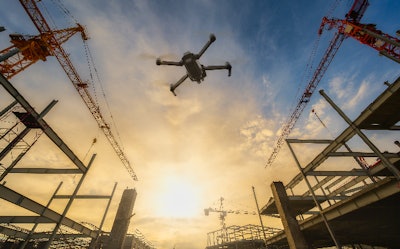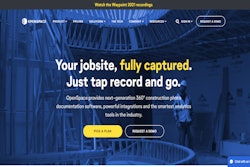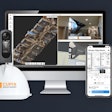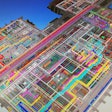
IRONPROS caught up in late January of 2023 with OpenSpace CEO Jeevan Kalanithi, and he indulged us as we fired some questions at him about, among other things, the construction reality capture company’s integration strategy with Procore, the extension of the OpenSpace platforms to drone data and Kalanithi’s vision for hard return-on-investment for customers.
OpenSpace has been broadly adopted by contractors ranging in size from the ENR top contractors to mid-tier contractors with a few hundred million in revenue to small mom-and-pops. OpenSpace offers a free version that may be a fit for the smallest contractors, but the cost to a small contractor that opts into a paid subscription will be based on their construction volume. A contractor constructing single family homes could be a fit, as could the largest subcontractors in the world working on horizontal construction.
OpenSpace may have more operational heft and North American customers than rivals including recent arrival, Constru, which established beachhead here in 2022. But they are not sitting on their laurels, opting instead to deepen and broaden the product on an ongoing basis. Central to these efforts is the OpenSpace Clearsight Progress Tracking product, which, using machine learning and computer vision, quantifies work put in place on the jobsite, creates dashboards and updates a BIM model. OpenSpace handles data collection through a 360-degree camera mounted to a construction helmet, and a site walk-through is all it takes to update progress with both photogrammetry and structured data reporting thanks to the way their machine vision tools unpack the visuals into a structured format.
READ THE IRONPROS OPENSPACE PRODUCT DEEP DIVE
OpenSpace Procore integration
IRONPROS has predicted that construction technology interoperability will accelerate in 2023, and Kalanithi may have been looking at the same tea leaves because OpenSpace at its recent user conference, announced a deepened integration with Procore.
“Our integration with Procore now covers a whole host of different workflows and use cases,” Kalanithi said. “We recently added punch lists to that, but prior to that, we had the ability to link data from OpenSpace into other workflows like requests for information and observations. And then in addition to that, we had the ability to allow our customers to log into OpenSpace via their Procore IDs, to simplify looking at their OpenSpace data from within the Procore dashboard.”
In this integration, OpenSpace data has been displayed in Procore through an inline frame (iFrame) window, but once OpenSpace users have linked their OpenSpace and Procore projects, they can:
- Achieve bidirectional integration between OpenSpace Field Notes and Procore RFIs and Observations, and synchronize updates back to OpenSpace
- Leverage a split screen to compare 360° images to previous captures but also to the BIM model
- Generate and manage RFIs and observations without leaving Procore
“The second level of this integration is that there's data within OpenSpace—the images of what is actually going on that people want to attach to specific jobs that they need to get completed,” Kalanithi said. “We do that with a functionality we have an OpenSpace called Field Notes. And a field note is just what it says it is—you are in the field, and you see something that needs to get dealt with. You can take a photo of it on your phone and OpenSpace knows where you are and can pin that image and all the information you add to it to the location and the time. That piece of information oftentimes is something that you want to link to an observation, or an RFI, or now a punch list item.”
This blocking-and-tackling approach enables OpenSpace to create a great deal of value, but that is before value from machine vision-driven capabilities, which can track and report on quantities of construction put in place, are factored in.
Integration with OpenSpace Track?
“I think there's a lot of opportunities there,” Kalanithi said when asked if that type of functionality would also integrate with Procore in the future. “For sure. We have a list of things, and that is one thing that I think could be cool.”
One way this data could be leveraged in Procore would be to support Procore Pay, the gap financing solution launched this year at the company’s Groundbreak conference. But just the increased transparency provided by digital reality capture and quantification could speed payment even without outside help.
“You can verify if something's actually completed,” Kalanithi said. “So, you can imagine customers can begin to simplify how they transact when a general contractor is paying a trade. The data in OpenSpace is a critical check that allows them to feel confident that they can release that payment. So that could be another integration point for us with Procore.”
In some other integration settings, Kalanithi said OpenSpace’s ability to quantity construction put in place using digital reality capture using OpenSpace Track is actually triggering business transactions in other business systems.
“One of the reasons why we built OpenSpace track in the first place,” Kalanithi said, referring to the functionality that in October of 2022 was rebadged from its original moniker of OpenSpace ClearSight Progress Tracking, “is to really give builders much more confidence about how their projects are going in a way that's easy for them to understand and, and react to and make decisions on. … And so we're hoping to simplify that and you can imagine a future where that is highly automated.”
This is a lofty but worthwhile goal because trade contractors shoulder the burden of aging receivables—according to one PWC study, 83 days to get paid is about par for the course.
“If we can make a dent in reducing those cash cycle times, I think that would be a really big deal,” Kalanithi said. “I mean, imagine that right? Then our customers can do things like, you know, invest in other parts of their business because they're not so strapped for cash all the time.”
READ THE IRONPROS PROCORE PRODUCT DEEP DIVE
Procore-As-An-Integration-Platform-As-A-Service
Procore integration is de rigueur for any construction software application, and Procore, or more specifically Procore’s partner strategy is now seen as a model for how construction interoperability will function. In a recent debriefing session, Trimble Vice President and General Manager, Construction Management Solutions (Viewpoint and MEP) Lawrence Smith, Smith suggested their recent acquisition of integration platform-as-a-service (IPaaS) vendor Ryvit was in part a nod to the success of Procore’s partner ecosystem. This acquisition not only gets Trimble the smarts and capacity to more quickly wire the various solutions that comprise the Trimble Construction One into an increasingly cohesive suite. But it also brings Trimble almost 30 solution partners that support the Ryvit API with integrations.
“I think Procore has clearly committed to that as part of their vision, and I think they've done a good job,” Kalanithi said. “It's clearly a model that works. I think it's working well for customers generally speaking, and it's a model that has worked in other industries too. And I think it's incumbent upon all of us that are providing solutions for the industry to just make sure that we make things easier for the customer so they can get the best solutions for the myriad of problems that they face.”
Using a partner ecosystem approach to interoperability, broad application vendors like Procore and Trimble can enable their customers to create solutions that support what Gartner would call the composable enterprise.
“I think they feel like they're not going to have best of breed solutions for every customer problem—that’s not feasible,” Kalanithi said. “And so, if they can create an ecosystem where customers can pull that together themselves, and those systems can play nice to each other, then that's what would be best for the market. And I of course agree with that.”
READ THE IRONPROS CONSTRUCTION INTEROPERABILITY PRIMER
OpenSpace for drones
IRONPROS is also tracking a trend of various reality capture technologies consolidating into centralized applications where they can be viewed and managed on a single pane of glass. OpenSpace started supporting LiDAR in 2022. In January of 2023 prior to our debriefing call, OpenSpace announced its support the Insta360 Sphere, an easy-to-install dual 360° camera that can be attached to DJI Mavic Air 2 and Air 2S drones. Paired with OpenSpace's technology, drone capture with Sphere flows aerial construction views into what is becoming the industry standard platform for photogrammetry progress tracking. Moving in this direction is something a lot of other vendors are doing right now, but it is more a return to form for Kalanithi.
“As you may or may not know, the first company I started was sold to a company called 3D Robotics,” Kalathini said. “And I'm in this industry because we launched drone-based imaging products for construction, you know, so, um, it's something I, I know very well.”
What observers can watch for from OpenSpace is a focus more aligned with the needs of vertical versus horizontal construction. Many of the more popular construction drone flight and image processing applications are focused on surveying or downward views from a light, fixed-wing drone. Sending a drone up a riser to capture mechanical as-builts before they are enclosed by concrete or along a façade to inspect quality involves a multi-rotor drone that can ascend and descend vertically and hover in place.
“You know, there are other uses of this technology for agriculture and things like that, and they have different needs and we're not interested in supporting those,” Kalathini said. “Because that's not the customers that we serve. We just asked what is a way we can support getting this data into our platform for our customers’ benefit with a focus on simplicity, ease of use, reliability and power. There's a lot of technology behind the scenes, but we really prioritize that simple user experience. So we saw this customer need and we implemented it.”
Reducing project risk
A more down-to-earth way Kalanithi is looking at driving immediate benefit for OpenSpace customers is by reducing their insurance rates.
“One thing that we're really excited about is, is the fact that the, that once you have the type of data that our technology provides, it really brings down the overall risk of a project, which kind of makes sense,” Kalathini said. “If you have a system of record and if there's a dispute, then you have that instant replay to see what's there. Also, if you have general contractor tracking their project with data like ours, that's less likely to have problems. So in insurance speak, that means that you'll have fewer losses on projects using our technology, and that if there is a claim, that it can be resolved and adjusted much more efficiently.”
This risk reduction according to Kalanithi enables a discount program with construction industry business insurance provider Shepherd. This program provides qualified contractors with underwriting credits and improved coverage on their Shepherd insurance policies, based on their OpenSpace usage.
“We believe use of this technology improves the risk equation, the underwriting for any given project,” Kalathini said. “I really find that exciting because a lot of the difficulty of construction, and there's lots of sources of it, is just the cost, especially these, these non-hard costs, like costs associated with payments or insurance.”
READ THE IRONPROS CONSTRUCTION PHOTOGRAMMETRY WIKI
BOTTOM LINE: Photogrammetry technology is becoming more ubiquitous in construction, but most contractors are only scratching the surface of what it can do once paired with machine vision technology to quantify construction work put in place. This type of technology is more widely applied to aerial drone photogrammetry where an aggregate provider will automate their inventory and stock pile tracking. OpenSpace has the reach and the substance to have staying power, so even if rivals like Constru run slightly ahead in some technical features, OpenSpace will be a safe bet and with a customer success team of about 50 as of 2022, they seem committed to helping contractors advance their adoption of the technology.















